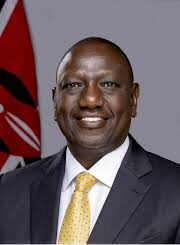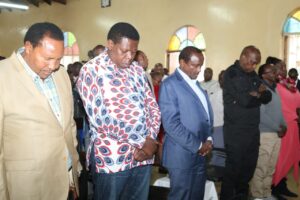Kalonzo Musyoka, a seasoned politician with decades of experience, is no stranger to the political limelight. Often seen as a “watermelon” or fence-sitter in the past, a perception that was deliberately popularized by Raila Odinga’s supporters in the media in a bid to stall his ambitions and cut him down, he has been criticized for his perceived indecisiveness. However, Musyoka is now striving to redefine his political identity, shedding his old labels and presenting himself as a decisive and mature leader ready to take on the highest office in the land.
His strategy seems to hinge on his reputation for integrity and his deep connections within Kenya’s political fabric. Kalonzo has been making significant efforts to expand his influence beyond his traditional Ukambani stronghold, seeking to build alliances in key regions such as Mt. Kenya. This move is seen as crucial, given the importance of regional support in Kenyan elections.
Strategic Alliances and Regional Outreach
Kalonzo’s efforts to build ties with the Mt. Kenya region have been a focal point of his strategy for the 2027 elections. Historically, this region has been a political kingmaker, with its large voter base and strategic significance. Kalonzo has been actively courting leaders from Mt. Kenya, engaging in dialogue with influential figures, and making concerted efforts to address the region’s concerns. Some of the leaders he has engaged include Jeremiah Kioni, the Jubilee Party Secretary General, Martha Karua, the Narc-Kenya Leader and former Kiambu Governor Ferdinand Waititu.
One key aspect of Kalonzo’s outreach in Mt. Kenya is his attempt to position himself as a unifying figure who can bring together different ethnic and political groups. Given that Mt. Kenya has traditionally supported candidates with a strong Kikuyu backing, Kalonzo faces the challenge of convincing the electorate that he can represent their interests. His efforts have included attending key regional events, participating in economic forums focused on the region, and advocating for policies that resonate with the Mt. Kenya voters, such as economic empowerment and agricultural development.
Moreover, Kalonzo’s alliance-building efforts are not limited to regional leaders. He is also working to win over influential business figures and youth leaders from Mt. Kenya, aiming to create a broad-based coalition that can challenge Ruto’s dominance. His outreach to the region is designed to counterbalance Ruto’s significant influence there, which was instrumental in the 2022 elections.
The Absence of Raila Odinga and Its Impact
Another significant factor in the 2027 presidential race is the potential absence of Raila Odinga. Raila, who has been a dominant figure in Kenyan politics for decades, is running for a position within the African Union Commission (AUC). If Raila steps down from active politics, this could create a vacuum in the opposition, which Kalonzo is well-positioned to fill. Raila has already reduced the impact of his own ODM Party on 2027 politics by sending his two deputies, Hassan Ali Joho and Wycliffe Oaparanya, and party chairman John Mbadi, to join the Ruito government in the strongest indication that he intends to throw his weight behind Ruto, rather than allow a different Luo leader to emerge in national politics and challenge for the Presidency or support Kalonzo, who has stood by him in three elections.
Kalonzo’s relationship with Raila has been complex. They have been allies in several political coalitions, most notably in the National Super Alliance (NASA) and the One Kenya Alliance (OKA). However, their partnership has also been marked by tensions and disagreements. Should Raila exit the political stage, Kalonzo had hoped to inherit his support base, particularly in the Nyanza and Western regions, which have been loyal to Raila for years. However, that is no longer obvious as Raila seems inclined to support Ruto, who wields state power at the moment and offers perks Kalonzo cannot match. But that will not prevent Kalonzo from presenting himself as Raiila’s successor, which partly explains the dilemma he has been in; whether to condemn Raila’s alliance with Ruto or be non-committal.
The potential departure of Raila could also weaken the opposition’s traditional hold on regions that are crucial for any presidential candidate. Kalonzo’s camp is likely to capitalize on this by presenting him as the natural successor to Raila’s political legacy. This would involve not only winning over Raila’s supporters but also positioning himself as the main opposition figure who can challenge Ruto’s government effectively.


The Challenge of the “Unholy Coalition”
Kalonzo’s challenge in the 2027 race is compounded by the recent developments that have seen an unlikely alliance between William Ruto’s United Democratic Alliance (UDA) and Raila Odinga’s Orange Democratic Movement (ODM). This coalition, which some have dubbed as an “unholy alliance,” could significantly reshape Kenya’s political landscape.
The coalition between Ruto and Raila, if it holds, could consolidate power and resources, making it harder for Kalonzo to break through. However, it also presents an opportunity for Kalonzo to position himself as the true alternative to the current political establishment. By distancing himself from the perceived compromises of both Ruto and Raila, Kalonzo could appeal to voters who are disillusioned with the current political class and are looking for a leader who represents change.
Kalonzo’s response to this coalition has been measured but firm. He has criticized the alliance as being more about political expediency than about the interests of the Kenyan people. This stance could resonate with voters who are wary of the traditional political elites and are seeking a leader who can offer a new direction.
While Kalonzo’s emergence as a presidential contender is gaining traction, he faces significant challenges. The incumbent, William Ruto, enjoys the advantage of incumbency and a strong political base. Ruto’s influence in regions like the Rift Valley and his appeal among certain voter demographics pose formidable obstacles for Kalonzo. Additionally, Ruto’s administration, despite facing criticism on various fronts, remains a powerful force that Kalonzo will need to outmaneuver.
However, Kalonzo’s appeal as a clean and experienced leader, combined with his ability to forge strategic alliances, could give him an edge. If he can successfully expand his influence in critical regions and maintain his reputation for integrity, Kalonzo could very well become the dark horse in the 2027 presidential race.
Stephen Kalonzo Musyoka’s journey toward the presidency is far from straightforward, but his recent moves suggest that he is a candidate who cannot be underestimated. As the 2027 elections approach, the battle between Kalonzo and Ruto is shaping up to be one of the most intriguing political contests in Kenya’s recent history. Kalonzo’s ability to navigate the complex political landscape, build alliances, and present a compelling alternative to the current administration will determine whether he can indeed become the man to beat in 2027.
